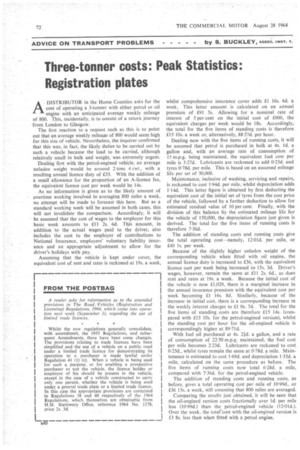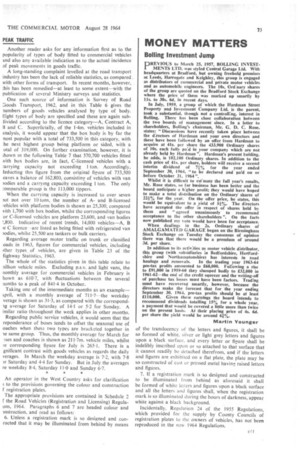Three-tonner costs: Peak Statistics: Registration plates
Page 74

Page 75

If you've noticed an error in this article please click here to report it so we can fix it.
ADISTRIBUTOR in the Home Counties asks for the cost of operating a 3-tonner with either petrol or oil engine with an anticipated average weekly mileage of 800. This, incidentally, is to consist of a return journey from London to Glasgow.
The first reaction to a request such as this is to point out that an average weekly mileage of 800 would seem high for this size of vehicle. Nevertheless, the inquirer confirmed that this was, in fact, the likely duties to be carried out by such a vehicle because the load to be carried, although relatively small in bulk and weight,was extremely urgent.
Dealing first with the petrol-engined vehicle, an average unladen weight would be around 2 tons 4 cwt., with a resulting annual licence duty of £33. With the addition of a small allowance for the proportion of an A-licence fee, the equivalent licence cost per week would be 14s.
As no information is given as to the likely amount of overtime working involved in averaging 800 miles a week, no attempt will be made to forecast this here. But as a standard working week will be assumed in both cases, this will not invalidate the comparison. Accordingly, it will be assumed that the cost of wages to the employer for this basic week amounts to £11 2s. 6d. This amount, in addition to the actual wages paid to the driver, also includes the cost to the employer of contributions to National Insurance, employers' voluntary liability insurance and an appropriate adjustment to allow for the driver's holidays with pay.
Assuming that the vehicle is kept under cover, the equivalent cost of rent and rates is reckoned at 19s. a week, whilst comprehensive insurance cover adds £1 16s. 6d. a week. This latter amount is calculated on an annual premium of £91 5s. Allowing for a nominal rate of interest of 5 per cent on the initial cost of £900, the equivalent charges per week would be 18s. Accordingly, the total for the five items of standing costs is therefore £15 10s. a week or, alternatively, 88.57d. per hour.
Dealing now with the five items of running costs, it will be assumed that petrol is purchased in bulk at 4s. ld. a gallon and, with an average rate of consumption of 15 m.p.g. being maintained, the equivalent fuel cost per mile is 3.27d. Lubricants are reckoned to add 0.23d. and tyres 0.78d. per mile. This is based on an assumed mileage life per set of 30,000.
Maintenance, inclusive of washing, servicing and repairs, is reckoned to cost 1.94d. per mile, whilst depreciation adds 1-14d. This latter figure is obtained by first deducting the equivalent cost of the initial set of tyres from the cost price of the vehicle, followed by a further deduction to allow for estimated residual value of 10 per cent. Finally, with the division of this balance by the estimated mileage life for the vehicle of 150,000, the depreciation figure just given is derived. The total for the five items of running costs is therefore 7.36d.
The addition of standing costs and running costs give the total operating cost-namely, 12.01d. per mile, or £40 Is. per week.
Because of the slightly higher unladen weight of the corresponding vehicle when fitted with oil engine, the annual licence duty is increased to £36, with the equivalent licence cost per week being increased to 15s. 3d. Driver's wages, however, remain the same at £11 2s. 6d., as does rent and rates at 19s. a week. Because the initial cost of the vehicle is now £1,029, there is a marginal increase in the annual insurance premium with the equivalent cost per week becoming £1 16s. 8d. Similarly, because of the increase in initial cost, there is a corresponding increase in the weekly interest charges to E1 Os. 7d. The total for the five items of standing costs are therefore £15 14s. (compared with £15 10s. for the petrol-engined version), whilst the standing cost per hour for the oil-engined vehicle is correspondingly higher at 89.71d.
With fuel oil purchased at 4s. nel. a gallon, and a rate of consumption of 22.50 m.p.g. maintained, the fuel cost per mile becomes 2.23d. Lubricants are reckoned to cost 0-25d., whilst tyres remain the same at 0-78d. a mile. Maintenance is estimated to cost 1-69d. and depreciation 1.33d. a mile, calculated on the same procedure as before. The five items of running costs now total 6-28d. a mile, compared with 7-36d. for the petrol-engined vehicle.
The addition of standing costs and running costs, as before, gives a total operating cost per mile of 10-99d., or £36 13s. a week, still assuming that 800 miles are averaged.
Comparing the results just obtained, it will be seen that the oil-engined version costs fractionally over Id. per mile less (10.99d.) than the petrol-engined vehicle (12-01d.). Over the week, the totarcost with the oil-engined version is £3 8s. less than when fitted with a petrol engine. Another reader asks for any information first as to the popularity of types of body fitted to commercial vehicles and also any available indication as to the actual incidence of peak movements in goods traffic.
A long-standing complaint levelled at the road transport industry has been the lack of reliable statistics, as compared. with other forms of transport. In recent months, however, this has been remedied—at least to some extent—with the publication of several Ministry surveys and statistics.
One such source of information is Survey of Road 5oods Transport, 1962, and in this Table 6 gives the :lumbers of goods vehicles analysed by type of body. Eight types of body are specified and these are again subiivided according to the licence category—A, Contract A, Et and C. Superficially, of the 1-4m. vehicles included in inalysis, it would appear that the box body is by far the most popular with a total of 733,500 in this category, with he next highest group being platform or sided, with a otal of 319,000. On further examination, however, it is ihown in the following Table 7 that 570,700 vehicles fitted vith box bodies are, in fact, C-licensed vehicles with a :arrying capacity not exceeding lion. Accordingly, leducting this figure from the original figure of 733,500 eaves a balance of 162,800, consisting of vehicles with van )odies and a carrying capacity exceeding 1 ton. The only :omparable group is the 113,000 tippers.
When the carrying capacity is increased to over seven )ut not over 10 tons, the number of Aand B-licensed ?chides with platform bodies is shown as 25,300, compared vith 1,700 with box bodies, whilst the corresponding figures or C-licensed vehicles are platform 23,600, and van bodies !,800. Indicative of recent trends, 14,000 vehicles—A, B )1. C licence -are listed as being fitted with refrigerated van mdies, whilst 25,500 are tankers or bulk carriers.
Regarding average motor traffic on trunk or classified oads in 1963, figures for commercial vehicles, including ither types_ of vehicles, are given in Table 23 of the iighway Statistics, 1963.
The whole of the statistics given in this table relate to Alton vehicle miles. Excluding p.s.v. and light vans, the nonthly average for commercial vehicles in February is hown as 610-7, with fluctuations between the several aonths to a peak of 841.4 in October.
Taking one of the intermediate months as an example—
with a monthly average of 711.7—the weekday verage is shown as 31-3, as compared with the correspondis average for Saturday of 14-1 or 5-2 for Sunday. A imilar ratio throughout the week applies in other months. Regarding public service vehicles, it would seem that the reponderance of buses tends to offset the seasonal use of °aches when these two tynes are bracketed together in le same group. Thus, the monthly average for March for .ises and coaches is shown as 211.7m. vehicle miles, whilst corresponding figure for July is 265.1. There is a gnificant contrast with goods vehicles as regards the daily verages. In March the weekday average is 7-2, with 7.8 )r Saturday and 4.4 for Sunday. But in July the averages re weekday 8-4. Saturday 11-0 and Sunday 6-7.
An operator in the West Country asks for clarification ; to the provisions governing the colour and construction f registration plates.
The appropriate provisions are contained in Schedule 2 f the Road Vehicles (Registration and Licensing) Regulaons, 1964. Paragraphs 6 and 7 are headed colour and vistruction, and read as follows: 6. Unless a registration mark is so designed and conructed that it may be illuminated from behind by means of the translucency of the letters and figures, it shall be so formed of white, silver or light grey letters and figures upon a black surface, and every letter or figure shall be
indelibly inscribed upon or so attached to that surface that it cannot readily be detached therefrom, and if the letters and figures are exhibited on a flat plate, the plate may be
so constructed of cast or pressed metal havim3 raised letters and figures.
7. If a registration mark is so designed and constructed to be illuminated from behind as aforesaid it shall be formed of white letters and figures uoon a black surface and all the letters and figures shall, when the registration mark is so illuminated during the hours of darkness, appear white against a black background, Incidentally. Regulation 24 of the 1955 Regulations, which provided for the supply by County Councils of registration plates to the owners of vehicles, has not been reproduced in the new 1964 Regulations.




















































































































